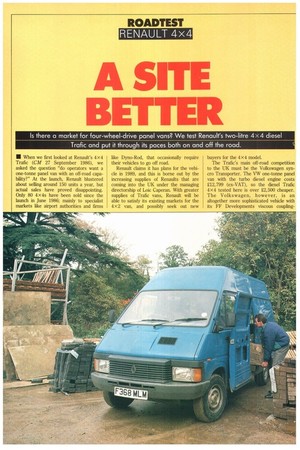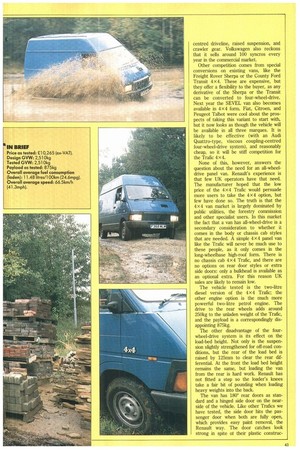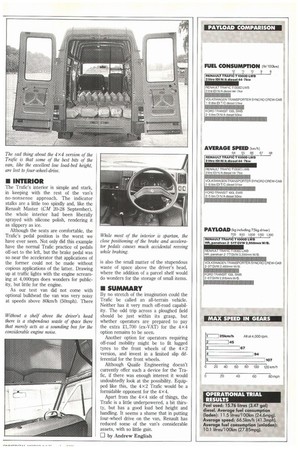A SITE BETTER
Page 38

Page 39

Page 40

Page 41

If you've noticed an error in this article please click here to report it so we can fix it.
Is there a market for four-wheel-drive panei vans? We test Renault's two-litre 4 >< 4 diesel Trafic and put it through its paces both on and off the road.
• When we first looked at Renault's 4x4 Trafic (CM 27 September 1986), we asked the question "do operators want a one-tonne panel van with an off-road capability?" At the launch, Renault blustered about selling around 150 units a year, but actual sales have proved disappointing. Only 80 4 x 4s have been sold since the launch in June 1986; mainly to specialist markets like airport authorities and firms like Dyno-Rod, that occasionally require their vehicles to go off road.
Renault claims it has plans for the vehicle in 1989, and this is borne out by the increasing supplies of Renaults that are coming into the UK under the managing directorship of Loic Caperan. With greater supplies of Trafic vans, Renault will be able to satisfy its existing markets for the 4X2 van, and possibly seek out new buyers for the 4X4 model.
The Trafic's main off-road competition to the UK must be the Volkswagen syncro Transporter, The VW one-tonne panel van with the turbo diesel engine costs £12,799 (ex-VAT), so the diesel Trafic 4x4 tested here is over £2,500 cheaper. The Volkswagen, however, is an altogether more sophisticated vehicle with its FF Developments viscous coupling centred driveline, raised suspension, and crawler gear. Volkswagen also reckons that it sells around 100 syncros every year in the commercial market.
Other competition comes from special conversions on existing vans, like the Freight Rover Sherpa or the County Ford Transit 4x4. These are expensive, but they offer a flexibility to the buyer, as any derivative of the Sherpa or the Transit can be converted to four-wheel-drive. Next year the SEVEL van also becomes available in 4x4 form. Fiat, Citroen, and Peugeot Talbot were cool about the prospects of taking this variant to start with, but it now looks as though the vehicle will be available in all three marques. It is likely to be effective (with an Audi Quattro-type, viscous coupling-centred four-wheel-drive system), and reasonably cheap, so it will be stiff competition for the Trafic 4 x 4.
None of this, however, answers the question about the need for an all-wheeldrive panel van. Renault's experience is that few UK operators have that need. The manufacturer hoped that the low price of the 4x4 Trafic would persuade more users to take the 4x4 option, but few have done so. The truth is that the 4x4 van market is largely dominated by public utilities, the forestry commission and other specialist users. In this market the fact that a van has all-wheel-drive is a secondary consideration to whether it comes in the body or chassis cab styles that are needed. A simple 4x4 panel van like the Trafic will never be much use to these people, as it only comes in the long-wheelbase high-roof form. There is no chassis cab 4x4 Trafic, and there are no options on rear door styles or extra side doors: only a bulkhead is available as an optional extra. For this reason UK sales are likely to remain low.
The vehicle tested is the two-litre diesel version of the 4x 4 Trafic; the other engine option is the much more powerful two-litre petrol engine. The drive to the rear wheels adds around 250kg to the unladen weight of the Trafic, and the payload is a correspondingly disappointing 875kg.
The other disadvantage of the fourwheel-drive system is its effect on the load-bed height. Not only is the suspension slightly strengthened for off-road conditions, but the rear of the load bed is raised by 125mm to clear the rear differential. At the front the load bed height remains the same, but loading the van from the rear is hard work. Renault has not fitted a step so the loader's knees take a fair bit of pounding when loading heavy weights into the back.
The van has 1800 rear doors as standard and a hinged side door on the nearside of the vehicle. Like other Trafics we have tested, the side door hits the passenger door when both are fully open, which provides easy paint removal, the Renault way. The door catches look strong in spite of their plastic construc tion, and there are two load-restraint eyes near the rear of the load bed.
Apart from the height of the load bed, we did not like the way the van creaks and groans, even on smooth surfaces. Apparently there is no extra strengthening under the load bed to cope with the demands of off-road use, and there must be a suspicion that the monocoque is starting to work even after 8,000km.
• PERFORMANCE
The diesel engine is the venerable fourpot wet liner, indirect-injection unit giving 45kW (60hp), and 119Nm (88.21bft). From the front the driveline consists of the all-alloy diesel engine, followed by the differential and Renault's NL7 gearbox. Rear-wheel-drive is achieved with an additional propshaft at the back of the gearbox that is activated with a simple lever on the right of the driver's seat. The lever slides a gear into mesh with the output shaft of the gearbox, and as the gear has a syncromesh cone incorporated, four-wheeldrive can be selected on the move.
Renault claims that with the rubber Rotoflex couplings on the rear propshaft there is little snatch when four-wheeldrive is activated, but as there is no central differential, the system will tend to wind itself up if used on tarmac roads. For this reason the Trafic must be driven in a straight line to get back to two-wheeldrive, or the lever refuses to come out of mesh.
There is virtually no difference between the 4x2 and the 4x 4 Trafic suspension layout. The same Macpherson struts are used at the front, with bottom wishbones to locate the independent suspension. At the rear a live axle is used located with semi-elliptic leaf springs, and telescopic dampers are fitted all round.
While the engine is a little short of power for the high-roof Trafic, it is a willing unit, and with Renault's short gearing, the performance is exciting, if a little noisy, up to 80km/h. Motorways, however, are hard work and tiring, especially when the van is fully laden.
Off road the engine and gearbox combine to provide good mobility on poor surfaces, as long as those surfaces are reasonably flat. The wheels rarely lose traction, and the Trafic will have no trouble on muddy surfaces even with its standard road tyres.
Part of the reason for this good traction also explains why the Trafic is such a dead loss at any other types of off-road surfaces; the engine is terribly short on power. There is no excess power to spin the wheels so the Trafic does not lose traction. Unfortunately this also means it will not climb hills either, and even large ruts on an otherwise flat surface will stop the French van in its tracks. At our Surrey test track the Trafic ground to a complete halt on a steep unsurfaced section without ever loosing grip; the engine just died.
When we tried to get a restart and even a 25% (1-in-4) tarmac slope the Trafic refused, and only by slipping the clutch did we manage to get a restart on a 20% (1-in-5) slope. We understand that there are some new engines for the Trafic next year, and the 4x4 Trafic could certainly do with one. No doubt the petrol engine would be better than the diesel at climbing hills, but the diesel's useful engine braking is not present on the spark ignition unit.
While the gearbox is great for urban delivery work, it is not suited for off-road either, and the Trafic desperately needs a crawler gear to climb hills. The box was also baulky on fast changes, and the synchromesh can be beaten in all the gears.
• ECONOMY
As we haven't tested many 4x4 vans there are few comparisons to make against the Trafic's fuel consumption of 11.48 litres/1001m (24.6mpg). The Volkswagen crewcab syncro (CM 22 November 1986) managed a more respectable 10.9 litres/100km (25.9mpg), although its turbo-diesel engine gave a lot more power than the Renault. Interestingly the extra 190kg of gross weight on the back of our Trafic T1300D long-term test van pulled its consumption back to 13.37 litres/ 100Iun (22.83mpg). This lends further weight to our argument that the engine is very underpowered at these sorts of gross weights, and any increase in the van's load will pull the consumption down by a disproportionate amount.
• HANDLING
We have often commented on the Trafic's good ride, and excellent cornering characteristics of gentle understeer. The fourwheel-drive system has not changed these characteristics, and on the road the van handles safely and comfortably.
Off road the situation changes infinitely for the worst, with all the best bits of the on-road handling contributing towards a thoroughly miserable time in the mud.
As the ride height has not been changed the Trafic will ground on all but the slightest of ruts. The retention of front independent suspension does not .help in this department either as the bottom wishbone mounts serve to act as scoops for the mud.
The suspension movement is not enough for an off-road vehicle either, so surfaces have to be flat if the Trafic is not to nose-dive into the nearest rut. Lastly the low-mounted exhaust pipe dips under the surface of all but the shallowest puddle, at which point the Trafic does a fair impression of a motor boat, and a stalled engine could suck water back into the exhaust system.
The front disc rear drum braking set-up is fine on the road, and stopping distances were short in tests, with good retardation. When they were filled with water the drums understandably did not provide such good braking, but the water soon drained off and normal good braking returned. The handbrake is not such a good performer, refusing to hold the Trafic back on even a 20% (1-in-5) slope. It is a good job that the van is unable to climb hills as it would soon be trundling back down them if left on the handbrake alone.
• INTERIOR
The Trafic's interior is simple and stark, in keeping with the rest of the van's no-nonsense approach. The indicator stalks are a little too spindly and, like the Renault Master (CM 20-28 September), the whole interior had been liberally sprayed with silicone polish, rendering it as slippery as ice.
Although the seats are comfortable, the Trafic's pedal position is the worst we have ever seen. Not only did this example have the normal Trafic practice of pedals off-set to the left, but the brake pedal was so near the accelerator that applications of the former could not be made without copious applications of the latter. Drawing up at traffic lights with the engine screaming at 4,000rpm does wonders for publicity, but little for the engine.
As our test van did not come with optional bulkhead the van was very noisy at speeds above 80km/h (50mph). There is also the small matter of the stupendous waste of space above the driver's head, where the addition of a parcel shelf would do wonders for the storage of small items.
• SUMMARY
By no stretch of the imagination could the Trafic be called an all-terrain vehicle. Neither has it very much off-road capability. The odd trip across a ploughed field should be just within its grasp, but whether operators are prepared to pay the extra 21,700 (ex-VAT) for the 4x4 option remains to be seen.
Another option for operators requiring off-road mobility might be to fit lugged tyres to the front wheels of the 4x2 version, and invest in a limited slip differential for the front wheels.
Although Quaife Engineering doesn't currently offer such a device for the Trafic, if there was enough interest it would undoubtedly look at the possibility. Equipped like this, the 4x2 Trafic would be a formidable opponent for the 4x 4.
Apart from the 4x4 side of things, the Trafic is a little underpowered, a bit thirsty, but has a good load bed height and handling. It seems a shame that in putting four-wheel drive on the van, Renault has reduced some of the van's considerable assets, with so little gain.
by Andrew English
























































